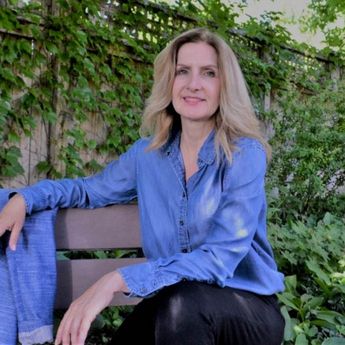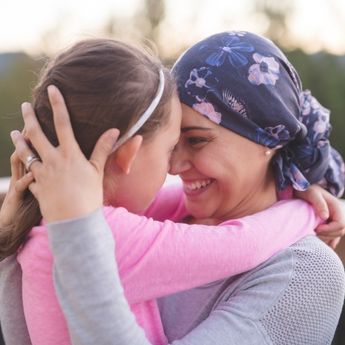 By MPP Laura Smith (Thornhill, ON)
By MPP Laura Smith (Thornhill, ON)
I have a worn-out, white T-shirt that has the symbolic pink ribbon on the front. It’s more than 15 years old and quite frayed from years of use. I wore it many years ago at my first walk for breast cancer with Princess Margaret, walking as part of a team that worked within the provincial courts. We named our group “Pink Justice.”
I remember the day vividly: as a time of solidarity with a group of friends, colleagues and survivors. It was a great day, the streets filled with incredible energy and glorious pink accessories, sunglasses, feather boas and countless women, and a few brave men, all joined in a moment of support. I proudly wore that first T-shirt not knowing that 15 years later, I would be more than a supporter—I would also be a survivor of breast cancer.
In the late fall of 2020, after a routine mammogram, I was asked to come in for further imaging and a series of tests. I was then escorted into a small room, a door was shut, and I was asked to pick up the phone. This was in one of the waves of COVID, so I sat in a room alone. No doctor, nurse, or any medical professional beside me. I sat down on a stool, picked up a ringing phone, and a doctor advised that they detected abnormal calcification in my left breast. I then walked upstairs where my family doctor practiced and asked the health care team, Anna and Janette, the fastest route in dealing with my health threat.
My surgeon, Dr. Adina Scheer, confirmed the abnormality, diagnosing it as early-stage DCIS: Ductal Carcinoma in Situ, also known as intraductal carcinoma. It rarely produces symptoms or a breast lump that can be felt, typically only being detected through a screening like a mammography. So, to put that into perspective, there was nothing that I felt in my body that triggered my mammogram.
In late November of 2020, I walked into the same hospital where I had my children, St. Michael’s, and underwent surgery, one of 2 lumpectomies, with the second surgery happening in late December 2020. In the early part of 2021, I received my small target tattoos, began radiation therapy, and completed 21 rounds by March of 2021.
I tried to stay busy throughout my journey. I continued to see clients, worked on several files, but also went for my treatments every morning. I treated my therapy like a process, and I attempted to minimize it when I was trying to describe things to my children. We were in the middle of a pandemic, and I did not want to add gasoline to the fire of their struggles. Because quite simply, I was going to survive.
When I would go to my follow-up appointments at Sunnybrook, the hallways to the breast centre were for the most part unoccupied. It was quite bizarre. Sadly, so many women choose to give themselves a pass on mammograms and their health, especially during COVID. Many health care professionals I spoke to described a tsunami of stage IV, or advanced cancers when women failed to take action during COVID.
In the late fall of 2021, I got on with my life. Six months after surgeries and treatment, I felt strong, and decided to run in the provincial election as the candidate in Thornhill; I was the first declared winner in Ontario.
No one on the campaign knew about my journey. I very reluctantly told my campaign manager when I needed to leave my “door knocking” activities to get a routine MRI. I swore him to silence because quite frankly, I disliked the look on people’s faces when I would talk about my diagnosis. The “poor you” expression made me feel less strong, so I made a conscious decision to not use cancer as a crutch in anything I did going forward.
After I was elected, I still kept silent about my cancer. It was deeply personal, and I was still not ready to discuss my journey. But as the months passed, I was constantly thinking about where I would be had I not received that mammogram. Early detection had possibly saved my life. But it was still my story, and I was not yet comfortable in sharing.
Then, in 2024, our government lowered the eligibility age for the Ontario Breast Screening Program from 50 to 40 years of age, allowing more women to self-refer. I had been quietly advocating for this, knowing this measure would save countless lives.
One day, in the caucus lounge, I finally decided to share my story with Sylvia Jones, the Minister of Health and the Deputy leader of our government. Minister Jones is a strong leader, and I knew she would be constructive and direct—a quality I believe we both shared.
And then, the flood gates opened. My story was released in a positive and constructive way that reminded everyone that early detection saves lives—full stop.
Along the way, I’ve learned two things. The first thing that I have reluctantly learned is that when you focus on problems, you will have more problems. But when you focus on possibilities, you will have more opportunities. I urge all women to take advantage of this early detection opportunity. And never be afraid to try something new. Life gets boring when you stay within the limits of what you already know.
The second thing that I have learned in my journey is that no matter how much something seems to challenge you, someday, you will look back and realize your struggle changed your life and helped you set a path forward.
I am here today—here for my community, and more importantly, here for my kids—because of early prevention.
That old white T-shirt still sits in my dresser, and I have no intention of tossing it anytime soon. Although I am not the sentimental type, that T-shirt has too much meaning for me. It’s a bit worn out, but it’s still here, just like me.






